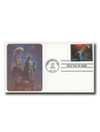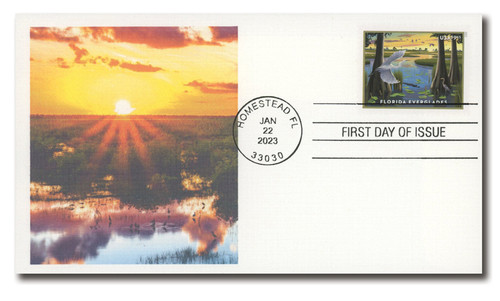
# 5827 FDC - 2024 $9.85 Pillars of Creation, Priority Mail
US #5827
2024 Pillars of Creation – Priority Mail
• The first non-American Landmarks Series Priority Mail stamp since 2008
• Pictures state-of-the-art image from NASA’s new James Webb Space Telescope
Stamp Category: Definitive
Value: $9.85 Priority Mail Rate
First Day of Issue: January 22, 2024
First Day City: Greenbelt, Maryland
Quantity Issued: 2,500,000
Printed by: Ashton Potter (USA) Ltd.
Printing Method: Offset, Microprint
Format: Panes of 4
Tagging: Nonphosphored Type III, Block Tag Applied
Why the stamp was issued: To cover the Priority Mail Rate and celebrate the groundbreaking images of NASA’s James Webb Space Telescope.
About the stamp design: Pictures an image of deep space taken by NASA’s James Webb Space Telescope. According to the USPS, this stamp shows “a digitally colored depiction of the invisible bands of mid-infrared light emitted by the Pillars of Creation. By assigning color to various wavelengths, the digitized image allows us to see a landscape otherwise invisible to the human eye. Red areas toward the end of the pillars show burgeoning stars ejecting raw materials as they form, while the relatively small red orbs scattered throughout the image show newly born stars. The image for this stamp was supplied in collaboration with NASA (National Aeronautics and Space Administration), ESA (European Space Agency), Canadian Space Agency, and the Space Telescope Institute.
First Day City: There was no First Day of Issue Ceremony, but the First Day of Issue postmark was from Greenbelt, Maryland, the location of NASA’s Goddard Space Flight Center which coordinated the development of the James Webb Space Telescope.
History the stamp represents: In 2024, the USPS issued a Priority Mail stamp picturing an image from the James Webb Space Telescope (JWST). It shows a photograph of the structures known as the “Pillars of Creation,” located within the deep space Eagle Nebula.
The Pillars of Creation were first photographed by the Hubble Space Telescope (the famous predecessor to JWST) on April 1, 1995. However, the massive formations of interstellar gas and dust were discovered in 1920 by John Charles Duncan. He first viewed them using the Mount Wilson Observatory’s 60-inch telescope in Los Angeles, California. The name “Pillars of Creation” came from the fact that the gas and dust that make up the structures are actively forming new stars. Without stars, life on any planet would be near-impossible (since space is otherwise freezing cold).
After many observations by different telescopes, scientists have slowly learned more about Pillars of Creation. For example, we know the entire structure is larger than our whole solar system! With JWST being the most advanced space telescope ever launched, NASA also got to see ejections from the young stars still being formed within the pillars. It will be fun to see what other impressive deep-space structures JWST will show us during its time in Earth’s orbit.
US #5827
2024 Pillars of Creation – Priority Mail
• The first non-American Landmarks Series Priority Mail stamp since 2008
• Pictures state-of-the-art image from NASA’s new James Webb Space Telescope
Stamp Category: Definitive
Value: $9.85 Priority Mail Rate
First Day of Issue: January 22, 2024
First Day City: Greenbelt, Maryland
Quantity Issued: 2,500,000
Printed by: Ashton Potter (USA) Ltd.
Printing Method: Offset, Microprint
Format: Panes of 4
Tagging: Nonphosphored Type III, Block Tag Applied
Why the stamp was issued: To cover the Priority Mail Rate and celebrate the groundbreaking images of NASA’s James Webb Space Telescope.
About the stamp design: Pictures an image of deep space taken by NASA’s James Webb Space Telescope. According to the USPS, this stamp shows “a digitally colored depiction of the invisible bands of mid-infrared light emitted by the Pillars of Creation. By assigning color to various wavelengths, the digitized image allows us to see a landscape otherwise invisible to the human eye. Red areas toward the end of the pillars show burgeoning stars ejecting raw materials as they form, while the relatively small red orbs scattered throughout the image show newly born stars. The image for this stamp was supplied in collaboration with NASA (National Aeronautics and Space Administration), ESA (European Space Agency), Canadian Space Agency, and the Space Telescope Institute.
First Day City: There was no First Day of Issue Ceremony, but the First Day of Issue postmark was from Greenbelt, Maryland, the location of NASA’s Goddard Space Flight Center which coordinated the development of the James Webb Space Telescope.
History the stamp represents: In 2024, the USPS issued a Priority Mail stamp picturing an image from the James Webb Space Telescope (JWST). It shows a photograph of the structures known as the “Pillars of Creation,” located within the deep space Eagle Nebula.
The Pillars of Creation were first photographed by the Hubble Space Telescope (the famous predecessor to JWST) on April 1, 1995. However, the massive formations of interstellar gas and dust were discovered in 1920 by John Charles Duncan. He first viewed them using the Mount Wilson Observatory’s 60-inch telescope in Los Angeles, California. The name “Pillars of Creation” came from the fact that the gas and dust that make up the structures are actively forming new stars. Without stars, life on any planet would be near-impossible (since space is otherwise freezing cold).
After many observations by different telescopes, scientists have slowly learned more about Pillars of Creation. For example, we know the entire structure is larger than our whole solar system! With JWST being the most advanced space telescope ever launched, NASA also got to see ejections from the young stars still being formed within the pillars. It will be fun to see what other impressive deep-space structures JWST will show us during its time in Earth’s orbit.












